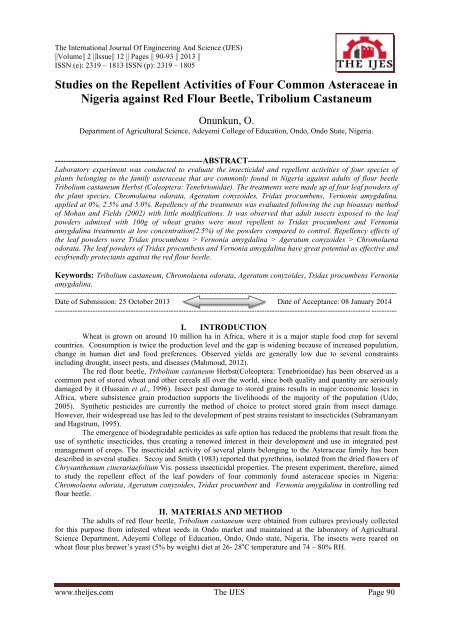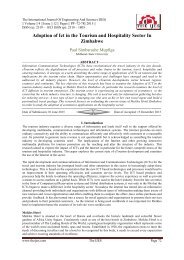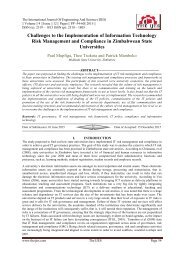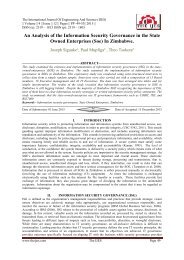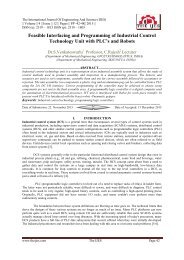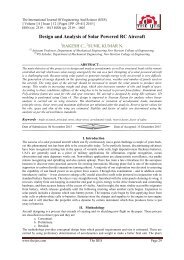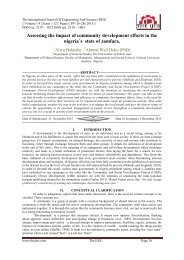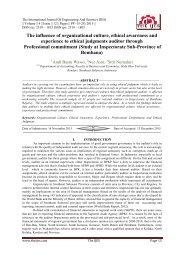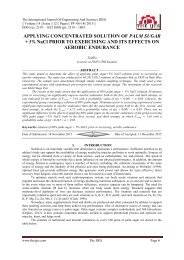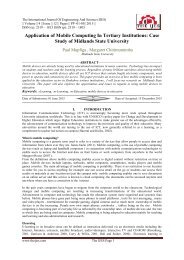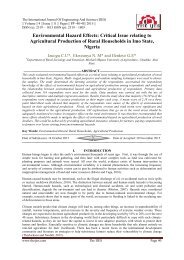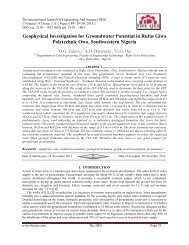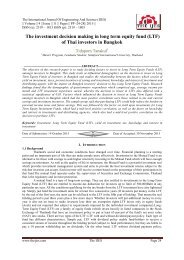M021203090093.pdf
You also want an ePaper? Increase the reach of your titles
YUMPU automatically turns print PDFs into web optimized ePapers that Google loves.
The International Journal Of Engineering And Science (IJES)<br />
||Volume|| 2 ||Issue|| 12 || Pages || 90-93 || 2013 ||<br />
ISSN (e): 2319 – 1813 ISSN (p): 2319 – 1805<br />
Studies on the Repellent Activities of Four Common Asteraceae in<br />
Nigeria against Red Flour Beetle, Tribolium Castaneum<br />
Onunkun, O.<br />
Department of Agricultural Science, Adeyemi College of Education, Ondo, Ondo State, Nigeria.<br />
-----------------------------------------------------ABSTRACT-----------------------------------------------------<br />
Laboratory experiment was conducted to evaluate the insecticidal and repellent activities of four species of<br />
plants belonging to the family asteraceae that are commonly found in Nigeria against adults of flour beetle<br />
Tribolium castaneum Herbst (Coleoptera: Tenebrionidae). The treatments were made up of four leaf powders of<br />
the plant species, Chromolaena odorata, Ageratum conyzoides, Tridax procumbens, Vernonia amygdalina,<br />
applied at 0%, 2.5% and 5.0%. Repellency of the treatments was evaluated following the cup bioassay method<br />
of Mohan and Fields (2002) with little modifications. It was observed that adult insects exposed to the leaf<br />
powders admixed with 100g of wheat grains were most repellent to Tridax procumbens and Vernonia<br />
amygdalina treatments at low concentration(2.5%) of the powders compared to control. Repellency effects of<br />
the leaf powders were Tridax procumbens > Vernonia amygdalina > Ageratum conyzoides > Chromolaena<br />
odorata. The leaf powders of Tridax procumbens and Vernonia amygdalina have great potential as effective and<br />
ecofriendly protectants against the red flour beetle.<br />
Keywords: Tribolium castaneum, Chromolaena odorata, Ageratum conyzoides, Tridax procumbens Vernonia<br />
amygdalina.<br />
----------------------------------------------------------------------------------------------------------------------------- ----------<br />
Date of Submission: 25 October 2013 Date of Acceptance: 08 January 2014<br />
----------------------------------------------------------------------------------------------------------------------------- ----------<br />
I. INTRODUCTION<br />
Wheat is grown on around 10 million ha in Africa, where it is a major staple food crop for several<br />
countries. Consumption is twice the production level and the gap is widening because of increased population,<br />
change in human diet and food preferences. Observed yields are generally low due to several constraints<br />
including drought, insect pests, and diseases (Mahmoud, 2012).<br />
The red flour beetle, Tribolium castaneum Herbst(Coleoptera: Tenebrionidae) has been observed as a<br />
common pest of stored wheat and other cereals all over the world, since both quality and quantity are seriously<br />
damaged by it (Hussain et al., 1996). Insect pest damage to stored grains results in major economic losses in<br />
Africa, where subsistence grain production supports the livelihoods of the majority of the population (Udo,<br />
2005). Synthetic pesticides are currently the method of choice to protect stored grain from insect damage.<br />
However, their widespread use has led to the development of pest strains resistant to insecticides (Subramanyam<br />
and Hagstrum, 1995).<br />
The emergence of biodegradable pesticides as safe option has reduced the problems that result from the<br />
use of synthetic insecticides, thus creating a renewed interest in their development and use in integrated pest<br />
management of crops. The insecticidal activity of several plants belonging to the Asteraceae family has been<br />
described in several studies. Secoy and Smith (1983) reported that pyrethrins, isolated from the dried flowers of<br />
Chrysanthemum cinerariaefolium Vis. possess insecticidal properties. The present experiment, therefore, aimed<br />
to study the repellent effect of the leaf powders of four commonly found asteraceae species in Nigeria:<br />
Chromolaena odorata, Ageratum conyzoides, Tridax procumbent and Vernonia amygdalina in controlling red<br />
flour beetle.<br />
II. MATERIALS AND METHOD<br />
The adults of red flour beetle, Tribolium castaneum were obtained from cultures previously collected<br />
for this purpose from infested wheat seeds in Ondo market and maintained at the laboratory of Agricultural<br />
Science Department, Adeyemi College of Education, Ondo, Ondo state, Nigeria. The insects were reared on<br />
wheat flour plus brewer’s yeast (5% by weight) diet at 26- 28 o C temperature and 74 – 80% RH.<br />
www.theijes.com The IJES Page 90
Studies on the Repellent Activities of Four Common Asteraceae in Nigeria against Red Flour Beetle…<br />
2.1 Selection and collection of plant species<br />
The selection of plants used in the study was based on previously reported insecticidal and repellence<br />
properties of the plants against storage insect pests. The plants, with the exception of Tridax procumbens,<br />
which was collected within Ondo town, were all collected from the main campus, Adeyemi College of<br />
Education, Ondo. The leaf part of the plant was plucked by hand and put in a jute bag. The plant materials were<br />
subsequently dried under shade for 6 days and pulverized using wooden pestle and mortal. Sieving of the<br />
pulverized plant materials was done and 100g of the prepared leaf powder was kept in an air tight container for<br />
the purpose of the experiment.<br />
2.2 Repellency study<br />
The repellency test adopted the cup bioassay method described by Mohan and Fields (2002) with little<br />
modifications. The leaf powders of the four plant species of asteraceae were evaluated for their repellent effect<br />
against red flour beetle, T. casternum at the rate of 0%, 2.5% and 5.0%. The experiment was a completely<br />
randomized design with five treatments and four replicates. The twenty adult insects that were used in the<br />
experiment were sieved out and placed gently in the middle of the perforated plastic container that holds 100g of<br />
wheat grains admixed with leaf powder and chemical insecticide treatments. Repellence was determined by the<br />
number of insects leaving the treated grain compared to the untreated controls.<br />
2.3 Statistical Analysis<br />
A two-way analysis of variance (ANOVA) was performed on data after transformation using square<br />
root and arcsine to determine repellent activity of the leaf powders of the four selected asteraceae at different<br />
concentrations and duration of exposure. Differences in mean repellency of treatments were compared using<br />
Students Newman Keuls(SNK) at p < 0.05.<br />
III. RESULTS<br />
The repellence of adult red flour beetle, Tribolium casternaeum to leaf powders of Chromolaena<br />
odorata, Ageratum conyzoides, Tridax procumbens and Vernonia amygdalina at different concentrations and<br />
period of exposure are depicted in figures 1, 2, 3, 4 and 5 respectively. The results indicate variation in<br />
repellence effectiveness of the selected plants. The rate of movement of adult red flour beetle from the<br />
perforated cylindrical cup which indicates repellence increased with increase in concentrations of the leaf<br />
powders and duration of exposure. The response of adults of T. castaneum to treatments of powders of the four<br />
asteraceae plant species was fastest for T. procumbens. At the highest concentration (5%) and duration of<br />
exposure(12 hours) adult red flour beetle elicited 79% repellence. This was closely followed by V. amygdalina<br />
with 68% repellence. The order of repellency effects of four powdered asteraceae species at the highest dosages<br />
and duration of exposure was Tridax procumbens > Vernonia amygdalina > Ageratum conyzoides ><br />
Chromolaena odorata.<br />
Figure 1. Repellency of Chromolaena odorata leaf powder to adult red flour beetle, Tribolium castaneum.<br />
www.theijes.com The IJES Page 91
Studies on the Repellent Activities of Four Common Asteraceae in Nigeria against Red Flour Beetle…<br />
Figure 2. Repellency of Ageratum conyzoides leaf powder to adult red flour beetle, Tribolium castaneum.<br />
Figure 3. Repellency of Vernonia amygdalina leaf powder to adult red flour beetle, Tribolium castaneum<br />
Figure 4. Repellency of Tridax procumbens leaf powder to adult red flour beetle, Tribolium castaneum<br />
Pascual-Villalobos and Robledo (1998) reported some asteraceae such as Anacyclus clavatus Pers.,<br />
Asteriscus maritimus Less., Artemisia campestris L., Atractylis humilis L., Centaurea aspera L., et cetera as<br />
effective repellents against adult red flour beetle,Tribolium castaneum. Gbolade et al., (1999) evaluated the<br />
effects of seed treatment and fumigation of artificially infested cowpea with the volatile oil of air-dried leaves of<br />
Ageratum conyzoides (Asteraceae) resulted in acute toxicity to adults of the cowpea weevil, Callosobruchus<br />
maculates and red flour beetle,Tribolium castaneum. Sahayraj and Paulraj (2000) observed that Spodoptera<br />
litura larva was repelled by groundnut leaves treated with Tridax procumbens leaf extract and the repellency<br />
increased as the concentration of leaf extract increased.<br />
www.theijes.com The IJES Page 92
Studies on the Repellent Activities of Four Common Asteraceae in Nigeria against Red Flour Beetle…<br />
Based on the present findings, it could be concluded that plant powders of some commonly found<br />
asteraceae in Nigeria could be exploited for their repellent properties against red flour beetle infesting wheat.<br />
The study has demonstrated that the leaf powders of these plants could serve as a veritable alternative<br />
protectants against the storage pest of wheat, red flour beetle , therefore avoiding all the side effects of synthetic<br />
pesticides.<br />
REFERENCES<br />
[1.] Gbolade A.A., Onayade O.A and Ayinde B.A(1999). Insecticidal activity of Ageratum conyzoides L volatile oil against<br />
Callosobruchus maculates F. in seed treatment and fumigation laboratory test. Insect Sci. Appl. 19: 237- 241.<br />
[2.] Hussain, A., Akram, W. and Khan, F.S., 1996. Determination of insecticide resistance in red flour beetle, Tribolium<br />
castaneum (Herbst) collected from Rawalpindi. Pakistan Ent., 8: 1-2.<br />
[3.] Mahmoud E Solh (2012). The importance of wheat for food security in Africa: Challenges and potential. Paper presentation at<br />
Wheat for Food Security in Africa conference, Oct 8, 2012, Addis Ababa, Ethiopia.<br />
[4.] Mohan S and Fields P.G (2002). A simple technique to assess compounds that are repellent or attractive to stored-product<br />
insects. Journal of Stored Products Research 38 (2002) 23–31<br />
[5.] Pascual-Villalobos M. J., Robledo A., 1998.- Screening for anti-insect activity in Mediterranean plants.- Industrial Crops<br />
and Products, 8: 183-194<br />
[6.] Secoy DM, Smith AE (1983).Use of plants in control of agricultural and domestic pests. Economic Botany 37(1): 28-57.<br />
[7.] Subramanyam, Bh., Hagstrum, D., 1995. Resistance measurement and management. In: Subramanyam, Bh., Hagstrum, D. (Eds.),<br />
Integrated Management of Insects in Stored Products. Marcel Dekker, Inc., New York, pp. 331–398<br />
[8.] Udo, I.O., 2005. Evaluation of the potential of some local spices as stored grain protectants against the maize weevil Sitophilus<br />
zeamais Mots (Coleoptera: Curculionidae). Journal of Applied Sciences and Environmental Management 9, 165-168.<br />
www.theijes.com The IJES Page 93


